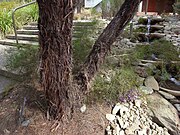Biology:Allocasuarina inophloia
| Allocasuarina inophloia | |
|---|---|

| |
| Scientific classification | |
| Kingdom: | Plantae |
| Clade: | Tracheophytes |
| Clade: | Angiosperms |
| Clade: | Eudicots |
| Clade: | Rosids |
| Order: | Fagales |
| Family: | Casuarinaceae |
| Genus: | Allocasuarina |
| Species: | A. inophloia
|
| Binomial name | |
| Allocasuarina inophloia | |

| |
| Occurrence data from AVH | |
Allocasuarina inophloia, commonly known as stringybark she-oak,[2] is a species of flowering plant in the family Casuarinaceae and is endemic to eastern Australia. It is a small dioecious tree that has finely fibrous, ribbony bark, its leaves reduced to scales in whorls of seven to nine, the mature fruiting cones 10–20 mm (0.39–0.79 in) long containing winged seeds (samaras) 5–6 mm (0.20–0.24 in) long.
Description
Allocasuarina inophloia is a dioecious tree with distinctive, finely fibrous, ribbony bark which typically grows to a height of 3–10 m (9.8–32.8 ft). Its branchlets are up to 210 mm (8.3 in) long, the leaves reduced to scale-like teeth 0.3–0.5 mm (0.012–0.020 in) long, arranged in whorls of seven to nine around the branchlets. The sections of branchlet between the leaf whorls (the "articles") are 4–7 mm (0.16–0.28 in) long and 0.5–0.6 mm (0.020–0.024 in) wide. Male flowers are arranged in spikes 20–40 mm (0.79–1.57 in) long, in whorls of 7 to 14 per centimetre (per 0.39 in.), the anthers 0.5–0.8 mm (0.020–0.031 in) long. The mature cones are 10–20 mm (0.39–0.79 in) long and 9–12 mm (0.35–0.47 in) in diameter containing dark brown samaras 5–6 mm (0.20–0.24 in) long.[2][3][4][5]
Taxonomy
This she-oak was first formally described in 1882 by Ferdinand von Mueller and Frederick Manson Bailey who gave it the name Casuarina inophloia in The Chemist and Druggist with Australasian Supplement.[6][7] In 1982, Lawrie Johnson transferred it to the new genus Allocasuarina as A. inophloia in the Journal of the Adelaide Botanic Gardens.[8] The specific epithet (inophloia) means "sinew-bark".[9]
Distribution and habitat
Allocasuarina inophloia grows in woodland on sandstone, ironstone or laterite ridges. It is found from near Herberton in Queensland to Torrington and Emmaville in New South Wales with a disjunct population in the Clarence River valley. In the Torrington area, it sometimes occurs in tall shrubland associated with species such as Allocasuarina brachystachya, Acacia williamsiana, Micromyrtus grandis and understorey shrubs such as Leucopogon neoanglicus and Calytrix tetragona.[2][3][10]
Ecology
Stringybark she-oak has been recorded as a host plant for the orange mistletoe (Dendrophthoe glabrescens).[11]
Use in horticulture
The shaggy bark of this species gives it horticultural potential. It is frost hardy and able to tolerate poor soils.[5]
Bark on a tree in the Australian National Botanic Gardens
References
- ↑ "Allocasuarina inophloia". https://biodiversity.org.au/nsl/services/apc-format/display/82285. Retrieved 13 June 2023.
- ↑ 2.0 2.1 2.2 Wilson, Karen L.; Johnson, Lawrence A.S.. "Allocasuarina inophloia". Royal Botanic Garden Sydney. https://plantnet.rbgsyd.nsw.gov.au/cgi-bin/NSWfl.pl?page=nswfl&lvl=sp&name=Allocasuarina~inophloia.
- ↑ 3.0 3.1 "Allocasuarina inophloia". Australian Biological Resources Study, Department of Agriculture, Water and the Environment: Canberra. https://profiles.ala.org.au/opus/foa/profile/Allocasuarina%20inophloia.
- ↑ Holliday, Ivan (1989). A Field Guide to Australian Trees. Melbourne: Hamlyn Australia. p. 44. ISBN 0-947334-08-4.
- ↑ 5.0 5.1 Ahrendt, Lucy (2006). "Allocasuarina inophloia". Growing Native Plants. Canberra, Australian Capital Territory: Australian National Botanic Gardens, Australian Government. http://www.anbg.gov.au/gnp/interns-2006/allocasuarina-inophloia.html. Retrieved 12 January 2012.
- ↑ "Casuarina inophloia". APNI. https://id.biodiversity.org.au/instance/apni/458475.
- ↑ von Mueller, Ferdinand; Bailey, Frederick M. (1882). "Remarks on a new Casuarina.". The Chemist and Druggist with Australasian Supplement 4 (48): 92. https://www.biodiversitylibrary.org/item/201709#page/168/mode/1up. Retrieved 13 June 2023.
- ↑ "Allocasuarina humilis". APNI. https://id.biodiversity.org.au/instance/apni/499337.
- ↑ Sharr, Francis Aubi; George, Alex (2019). Western Australian Plant Names and Their Meanings (3rd ed.). Kardinya, WA: Four Gables Press. p. 224. ISBN 9780958034180.
- ↑ Hunter, John T.; Clarke, Peter J. (1998). "The Vegetation of granitic outcrop communities on the New England Batholith of eastern Australia". Cunninghamia 5 (3): 566. https://www.biodiversitylibrary.org/item/267458#page/24/mode/1up. Retrieved 13 June 2023.
- ↑ Downey, Paul O. (1998). "An inventory of host species for each aerial mistletoe species". Cunninghamia 5 (3): 709. https://www.biodiversitylibrary.org/item/267458#page/167/mode/1up. Retrieved 13 June 2023.
Wikidata ☰ Q2815171 entry
 |



